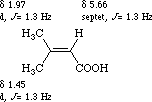 |
Nuclear Overhauser Effect
Use the Back Arrow to return to a spectroscopy problem
 |
Return to NMR Home Page
Return to Spin-Coupling
A population of nuclei in a magnetic field achieve an equilibrium with respect to spin state with a small excess of nuclei in the lower energy state due to the operation of certain radiationless energy transfer mechanisms termed relaxation processes. In spin-spin relaxations, a nucleus in an upper energy level transfers energy to a neighboring nucleus of the same isotope by mutual exchange of spin, resulting in diminished lifetimes of particular excited states. In spin-lattice relaxation, the energy of the high nuclear spin is converted into thermal energy and transferred throughout the system. This results directly in the maintenance of unequal populations of the two spin states. One of the major mechanisms for this transfer involve dipole-dipole interactions. For nuclei which are close together ( 3.5 angstroms), the saturation of one nucleus (promotion to the high spin state), results in energy transfer to the other, with the net effect of enhancing the NMR signal of the second nucleus. This effect is termed the Nuclear Overhauser Effect (NOE), and for spatially interacting protons, can result in a 50% increase in signal intensity, while for
3.5 angstroms), the saturation of one nucleus (promotion to the high spin state), results in energy transfer to the other, with the net effect of enhancing the NMR signal of the second nucleus. This effect is termed the Nuclear Overhauser Effect (NOE), and for spatially interacting protons, can result in a 50% increase in signal intensity, while for 
 C
C
 H interactions, the increase is often over 200%.
H interactions, the increase is often over 200%.
The use of this for structure elucidation is demonstrated by the following example:
The  H NMR of
H NMR of  ,
, -dimethyl acrylic acid (3-methylbut-2-enoic acid) shows a small coupling constant between the methyl groups and the proton in the 2-position
-dimethyl acrylic acid (3-methylbut-2-enoic acid) shows a small coupling constant between the methyl groups and the proton in the 2-position

Irradiation of either of the methyl signals results in decoupling of the proton signal, reducing the multiplicity from a septet to a quartet. Irradiation of the methyl signal at  1.97, however, results in an enhancement of the proton signal by about 17%, while no effect was observed when the other methyl group was irradiated. The conclusion is that the peak at
1.97, however, results in an enhancement of the proton signal by about 17%, while no effect was observed when the other methyl group was irradiated. The conclusion is that the peak at  1.97 corresponds to the methyl group that is cis to the proton and is therefore spatially closer.
1.97 corresponds to the methyl group that is cis to the proton and is therefore spatially closer.
In 
 C NMR, the NOE is utilized to significantly enhance the normally weak NMR signal. The sample is irradiated with broad-band radiation to saturate all proton spins. Spin-lattice energy transfer occurs to the attached carbons and the NMR signals are greatly enhanced. The use of this technique allows
C NMR, the NOE is utilized to significantly enhance the normally weak NMR signal. The sample is irradiated with broad-band radiation to saturate all proton spins. Spin-lattice energy transfer occurs to the attached carbons and the NMR signals are greatly enhanced. The use of this technique allows 
 C NMR spectra to be collected in a relatively short time, but, since the intensity of the NOE depends on the number of attached protons and other possible mechanisms for spin-lattice energy transfer, the resulting integration is no longer proportional to the number of
C NMR spectra to be collected in a relatively short time, but, since the intensity of the NOE depends on the number of attached protons and other possible mechanisms for spin-lattice energy transfer, the resulting integration is no longer proportional to the number of 
 C nuclei giving rise to the signal; i.e., the integration of these spectra is essentially meaningless.
C nuclei giving rise to the signal; i.e., the integration of these spectra is essentially meaningless.
View  H NMR Correlation Table
H NMR Correlation Table
View 
 C NMR Correlation Table
C NMR Correlation Table
Back to NMR Home Page